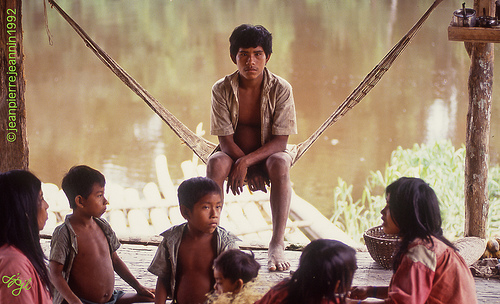Print  |
|


Account from a field linguist in Amazonia
Posted by Elsa Gomez-Imbert on October 29, 2011
By Elsa Gomez-Imbert, research associate, French Institute for Andean Studies.

ethnie des Urarinas (Amazonie)
An abiding experience
Working in the field in northwestern Amazonia has been the most striking experience of my life. From the summer of 1973 to the spring of 1998, I made several stays in communities who speak languages of the eastern branch of the Tukano family: Bará, Barasana, Edúuria, Karapana, Makuna, Tatuyo, Tuyuka.
These groups are located in the region of Vaupés, Colombia, near the Brazilian boarder. They live on the banks of a river whose dark tea colored waters flow along stretches of thin white sand: the Piraparaná. There, traditional housing, with common homes (malocas) sheltering several nuclear families, generalized multilingualism, the rituals, and material culture, remain preserved and handed down from one generation to the other.
These visits have been real life lessons in the relations to others and nature, they’ve made me change the way I see the world. Unfortunately my expeditions had to stop when the guerilla started to invade the region.
A lesson for multilingualism
I began by engaging the study of the Tatuyo language, and then the Barasana language. I was able to reach from one language to the other without resorting to Spanish thanks to these peoples’ unusual marriage system and the multilingualism it generates.
In the Tukano groups, as it happens, the “ethnic group” is defined by common male ancestors. Everyone must demonstrate their filiation through the daily and exclusive use of their father language. And they have to marry someone with a different paternal lineage, thus belonging to a different linguistic group. This is what we call “linguistic exogamy”. As a result, husband and wife communicate in different languages, and children learn at least two languages right from the cradle – a mother tongue, and a father tongue.
Thus monolingualism is essentially non-existent in these societies. Sharing their daily life, I was immerged in the most fascinating sociolinguistic context.
The generalized practice of multilingualism helped me understand certain characteristics such as tones, which would have been impossible otherwise.
Pleasures of a field linguist
Field linguists describe the languages they encounter, which yields to many satisfactions. It is one thing to learn through textbooks that certain languages bear features “exotic” to those who do not speak them; discovering them in the field feels like you have created them.
Detecting a tonal distinction that changes meaning, having to choose a form of conjugation according to how you learned about an event, or indicating certain qualities of an object (round, long, hollow, full) with grammatical markers are an excellent kind of mental gym.
Describing languages is a way to introduce them to the scientific world and contribute to their transmission. Revealing, years later, the originality of these languages to their very own enthusiastic speakers is a reward that widely makes up for the inconvenience of mosquitoes and chiggers.
Anthropology as a key to understanding and exchange
Nowadays most of the languages of Amazonia are threatened with extinction:
– because of a limited number of speakers: a few hundred, possibly a few dozen, and even, in a number of cases, only a handful of people;
– by the prestige of national languages such as Spanish, Portuguese, and even French in French Guiana.
Preserving these languages and the knowledge of the Amazonian environment they express is a concern we must inspire to budding linguists.
I would particularly recommend they read Claude Lévi-Strauss, whose books tagged along my first expeditions and granted me interesting exchange with my Tatuyo and Karapana hosts. They were delighted to hear, for instance, about the variations of certain mythic themes that are part of their knowledge, which Lévi-Strauss introduced in The Raw and the Cooked, my bedside reading at the time.
Another of his books, The Jealous Potter, had been the occasion of an absorbing epistolary exchange with the great thinker. In my field records I had come upon a myth in Tatuyo language that was built exactly according to the model expounded by Lévi-Strauss on the construction of myths on the origins of pottery. I was struck by the accuracy of his intuition.
◊
References:
Gomez-Imbert Elsa (1990). « Façon des poteries (mythe tatuyo sur l’origine de la poterie) ». Amerindia 15, pp. 193-227. Paris : AEA (available for download at http://www.vjf.cnrs.fr/celia/)
__. (1991). « Force des langues vernaculaires en situation d’exogamie linguistique : le cas du Vaupés colombien (Nord-ouest amazonien) ». In Charmes J., éd., Plurilinguisme et développement. Cahiers des Sciences Humaines 27.3-4, pp. 535-559. Paris : Ed. ORSTOM, available for download at www.ird.fr).
––. (2011). « La famille tukano ». Dictionnaire des langues du monde. Paris : Presses Universitaires de France, pp. 1454-1460.
––. (2011). « Le tatuyo ». Dictionnaire des langues du monde. Paris : Presses Universitaires de France, pp. 1554-1561.








